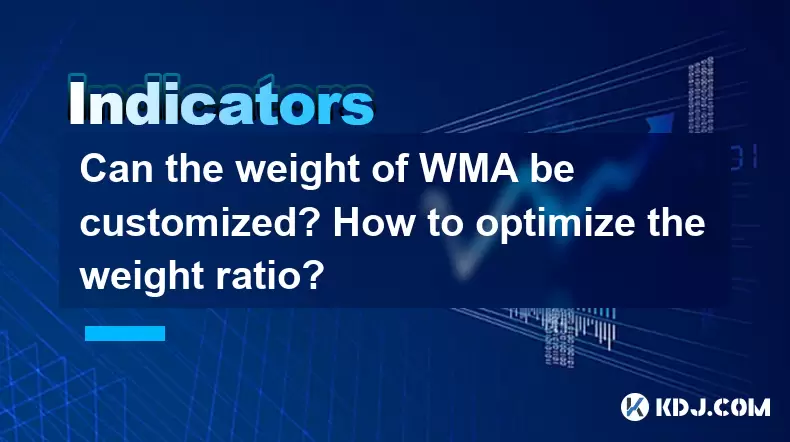-
 bitcoin
bitcoin $118548.520763 USD
3.67% -
 ethereum
ethereum $4352.564943 USD
4.79% -
 xrp
xrp $2.964058 USD
4.22% -
 tether
tether $1.000565 USD
0.05% -
 bnb
bnb $1028.372955 USD
1.46% -
 solana
solana $221.373507 USD
6.00% -
 usd-coin
usd-coin $0.999933 USD
0.02% -
 dogecoin
dogecoin $0.248633 USD
6.85% -
 tron
tron $0.341444 USD
2.38% -
 cardano
cardano $0.852946 USD
5.82% -
 hyperliquid
hyperliquid $47.869306 USD
6.15% -
 chainlink
chainlink $22.561476 USD
6.01% -
 ethena-usde
ethena-usde $1.001258 USD
0.05% -
 avalanche
avalanche $30.660000 USD
2.06% -
 stellar
stellar $0.400917 USD
9.76%
Can the weight of WMA be customized? How to optimize the weight ratio?
The Weighted Moving Average can be customized by altering weights to suit trading strategies, using linear, exponential, or arbitrary methods for optimization.
May 21, 2025 at 06:14 pm

Can the Weighted Moving Average (WMA) Be Customized? How to Optimize the Weight Ratio?
The Weighted Moving Average (WMA) is a popular technical analysis tool used by cryptocurrency traders to smooth out price data and identify trends. Unlike the Simple Moving Average (SMA), which assigns equal weight to all data points, the WMA assigns different weights to data points, with more recent data given greater importance. This raises the question: can the weights of the WMA be customized, and if so, how can one optimize the weight ratio for better trading decisions?
Understanding WMA and Customization
The core principle of the WMA is to give more significance to recent price data, thereby providing a more responsive indicator to the latest market movements. The formula for calculating WMA is as follows:
[ \text{WMA} = \frac{n \cdot Pn + (n-1) \cdot P{n-1} + ... + 2 \cdot P_2 + 1 \cdot P_1}{n + (n-1) + ... + 2 + 1} ]
where ( n ) is the number of periods, and ( P_n ) is the price at period ( n ).
Customization of the WMA involves altering the weight assigned to each data point. By default, the weights are linearly decreasing, with the most recent data point receiving the highest weight. However, traders can customize these weights to better suit their trading strategies or market conditions.
Methods to Customize WMA Weights
Customizing the weights of a WMA can be achieved through various methods, each with its own set of considerations. Here are some common approaches:
Linear Customization: This is the most straightforward method where the weights decrease linearly but start from a different value than the default. For example, instead of starting at ( n ), you might start at ( 2n ) to give even more emphasis to recent data.
Exponential Customization: Instead of a linear decrease, weights can decrease exponentially. This method can be useful for traders who believe recent data should have a significantly higher impact on the average.
Arbitrary Weight Assignment: Traders can assign weights based on their own analysis or trading strategy. For instance, if a trader believes certain periods are more important due to market events, they can assign higher weights to those periods.
Steps to Customize WMA Weights
To customize the weights of a WMA, follow these detailed steps:
Identify the Period: Determine the number of periods ( n ) you want to use for your WMA. This could be 10, 20, or any other number based on your trading strategy.
Choose a Customization Method: Decide on the method you will use for customizing the weights. This could be linear, exponential, or arbitrary.
Assign Weights: Based on your chosen method, assign weights to each period. For example, if using linear customization starting at ( 2n ), the weights would be ( 2n, 2n-1, 2n-2, ..., 2, 1 ).
Calculate the WMA: Use the formula provided earlier, but with your custom weights, to calculate the WMA.
Backtest and Adjust: Apply your custom WMA to historical data to see how it performs. Adjust the weights as necessary to optimize the results.
Optimizing the Weight Ratio
Optimizing the weight ratio of a WMA involves finding the right balance that maximizes the effectiveness of the indicator for your trading strategy. Here are some strategies to consider:
Historical Data Analysis: Use historical price data to test different weight ratios and see which ones provide the best signals for your trading strategy. This can involve backtesting your WMA with various weight configurations.
Market Conditions: Adjust the weights based on current market conditions. For example, during periods of high volatility, you might want to give more weight to recent data to capture rapid price movements.
Trading Strategy Alignment: Ensure that the weight ratio aligns with your overall trading strategy. If you are a short-term trader, you might prefer a WMA with a higher emphasis on recent data compared to a long-term investor.
Tools for Customizing and Optimizing WMA
Several trading platforms and software tools allow traders to customize and optimize the WMA. Here are a few examples:
- TradingView: This platform offers a Pine Script editor where traders can write custom scripts to modify the WMA weights. You can use the following code as a starting point:
//@version=4study('Custom WMA', shorttitle='CWMA', overlay=true)n = input(10, title='Periods')weights = array.new_float(0)sum_weights = 0.0
for i = 0 to n - 1
weight = n - i
array.set(weights, i, weight)
sum_weights := sum_weights + weight
wma = 0.0for i = 0 to n - 1
wma := wma + array.get(weights, i) * close[i] / sum_weights
plot(wma, color=color.blue, title='Custom WMA')
MetaTrader 4/5: These platforms allow for custom indicators to be created using MQL4/5. You can write a script to calculate a WMA with custom weights and add it to your trading charts.
Excel: For those who prefer a more manual approach, Excel can be used to calculate WMA with custom weights. Set up a spreadsheet with columns for price data, weights, and the WMA calculation.
Practical Example of Customizing WMA
Let's walk through a practical example of customizing the WMA using a 10-period WMA with exponential weights. Suppose we want to assign weights that decrease exponentially, starting with a base of 2.
Step 1: Define the periods and weights. For a 10-period WMA, the weights would be ( 2^9, 2^8, 2^7, ..., 2^0 ).
Step 2: Calculate the sum of the weights. The sum of the weights in this case would be ( 2^9 + 2^8 + 2^7 + ... + 2^0 = 1023 ).
Step 3: Apply the weights to the price data. If the prices over the last 10 periods are ( P_1, P2, ..., P{10} ), the WMA would be calculated as:
[ \text{WMA} = \frac{2^9 \cdot P_{10} + 2^8 \cdot P_9 + ... + 2^0 \cdot P_1}{1023} ]
- Step 4: Plot the WMA on your chart and compare it to the default WMA to see how the custom weights affect the indicator.
Frequently Asked Questions
Q: Can I use different weight customization methods for different cryptocurrencies?A: Yes, you can customize the WMA weights differently for different cryptocurrencies based on their unique market behaviors and your trading strategy for each asset.
Q: How often should I adjust the WMA weights?A: The frequency of adjusting WMA weights depends on your trading strategy and market conditions. Some traders might adjust weights weekly or monthly, while others might do so more frequently based on market volatility.
Q: Is there a risk of overfitting when optimizing WMA weights?A: Yes, there is a risk of overfitting if you adjust the weights too frequently or based on too small a sample of historical data. It's important to use a robust dataset and validate your results across different market conditions.
Q: Can WMA be used in conjunction with other indicators?A: Absolutely, WMA can be used alongside other technical indicators such as RSI, MACD, or Bollinger Bands to create a more comprehensive trading strategy.
Disclaimer:info@kdj.com
The information provided is not trading advice. kdj.com does not assume any responsibility for any investments made based on the information provided in this article. Cryptocurrencies are highly volatile and it is highly recommended that you invest with caution after thorough research!
If you believe that the content used on this website infringes your copyright, please contact us immediately (info@kdj.com) and we will delete it promptly.
- BlockDAG, DOGE, HYPE Sponsorship: Crypto Trends Shaping 2025
- 2025-10-01 00:25:13
- Deutsche Börse and Circle: A StableCoin Adoption Powerhouse in Europe
- 2025-10-01 00:25:13
- BlockDAG's Presale Buzz: Is It the Crypto to Watch in October 2025?
- 2025-10-01 00:30:13
- Bitcoin, Crypto, and IQ: When Genius Meets Digital Gold?
- 2025-10-01 00:30:13
- Stablecoins, American Innovation, and Wallet Tokens: The Next Frontier
- 2025-10-01 00:35:12
- NBU, Coins, and Crypto in Ukraine: A New Yorker's Take
- 2025-10-01 00:45:14
Related knowledge

What is a tower bottom candlestick pattern? Does it have a high success rate?
Sep 22,2025 at 07:18am
Tower Bottom Candlestick Pattern Explained1. The tower bottom candlestick pattern is a reversal formation that typically appears at the end of a downt...

What is a black hole pattern in the MACD indicator? Is it a cause for concern?
Sep 21,2025 at 06:54pm
Bitcoin's Role in Decentralized Finance1. Bitcoin remains the cornerstone of decentralized finance, serving as a benchmark for value and security acro...

How can I use the psychological line (PSY) to determine market sentiment?
Sep 17,2025 at 02:19pm
Understanding the Psychological Line (PSY) in Cryptocurrency TradingThe Psychological Line, commonly referred to as PSY, is a momentum oscillator used...

How can I determine if a double top pattern has officially formed?
Sep 21,2025 at 03:18am
Understanding the Structure of a Double Top Pattern1. A double top pattern consists of two distinct peaks that reach approximately the same price leve...

What is the Golden Valley pattern on the moving average? Is it better than the Silver Valley pattern?
Sep 21,2025 at 02:54pm
Understanding the Golden Valley Pattern in Moving Averages1. The Golden Valley pattern is a technical formation observed in cryptocurrency price chart...

What does a death cross of the RSI in the strong zone (above 50) mean?
Sep 17,2025 at 10:54pm
Understanding the Death Cross in RSI Context1. The term 'death cross' is traditionally associated with moving averages, where a short-term average cro...

What is a tower bottom candlestick pattern? Does it have a high success rate?
Sep 22,2025 at 07:18am
Tower Bottom Candlestick Pattern Explained1. The tower bottom candlestick pattern is a reversal formation that typically appears at the end of a downt...

What is a black hole pattern in the MACD indicator? Is it a cause for concern?
Sep 21,2025 at 06:54pm
Bitcoin's Role in Decentralized Finance1. Bitcoin remains the cornerstone of decentralized finance, serving as a benchmark for value and security acro...

How can I use the psychological line (PSY) to determine market sentiment?
Sep 17,2025 at 02:19pm
Understanding the Psychological Line (PSY) in Cryptocurrency TradingThe Psychological Line, commonly referred to as PSY, is a momentum oscillator used...

How can I determine if a double top pattern has officially formed?
Sep 21,2025 at 03:18am
Understanding the Structure of a Double Top Pattern1. A double top pattern consists of two distinct peaks that reach approximately the same price leve...

What is the Golden Valley pattern on the moving average? Is it better than the Silver Valley pattern?
Sep 21,2025 at 02:54pm
Understanding the Golden Valley Pattern in Moving Averages1. The Golden Valley pattern is a technical formation observed in cryptocurrency price chart...

What does a death cross of the RSI in the strong zone (above 50) mean?
Sep 17,2025 at 10:54pm
Understanding the Death Cross in RSI Context1. The term 'death cross' is traditionally associated with moving averages, where a short-term average cro...
See all articles










































































